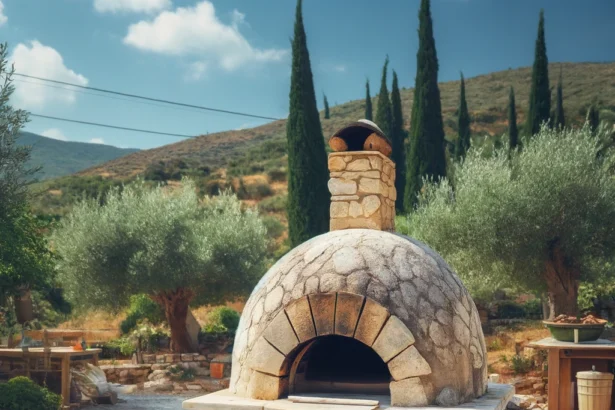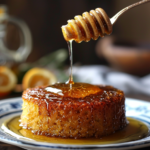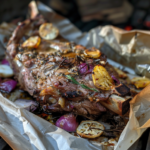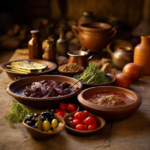Introduction to Greek Wood-Fired Ovens
In the heart of Greek culinary tradition lies the Greek wood-fired oven, a timeless artifact that has been central to Greek cooking for centuries. Known for imparting a unique smoky flavor that modern ovens can scarcely replicate, these ovens are a testament to the enduring nature of Greek culinary methods.
The History of Wood-Fired Oven in Greek Cuisine
Greek wood-fired oven have a storied history, evolving from ancient clay structures to the more robust constructions seen today. Initially used for bread and communal meals, these ovens have sustained families and fueled gatherings, embedding themselves as cultural staples in Greek life.
Design and Construction of Greek Wood-Fired Oven
Traditional Greek wood-fired ovens are masterpieces of rural engineering, typically made from locally sourced clay and stone. Their dome-shaped design and thick walls create a heat-retentive environment that is ideal for slow-cooked flavors and perfectly crusty bread.

The Science Behind Wood-Fired Cooking
The allure of the wood-fired oven isn’t just in its tradition but also in its science. The high, consistent heat ensures rapid cooking, which seals moisture and flavor inside, while the wood smoke envelops food in an irreplaceable aroma, enhancing the overall taste.
Preparing the Greek Wood-Fired Oven for Baking
Operating a wood-fired oven involves precision. The process begins with selecting the right wood, typically hard, dry, and resin-free, to avoid soot and ensure a clean burn. Heating the oven can take several hours, requiring constant attention to temperature and flame.
Traditional Greek Recipes for the Greek Wood-Fired Oven
From crusty loaves of bread to succulent lamb dishes and hearty vegetable casseroles, Greek recipes thrive in the wood-fired oven. Dishes like spanakopita and moussaka are also transformed by the smoky richness that these ovens provide.
Techniques for Mastering Wood-Fired Baking
Mastering the wood-fired oven requires practice and patience. Key techniques include managing the fire’s intensity, using the oven’s different heat zones, and understanding the timing required for different dishes.
Benefits of Baking in a Wood-Fired Oven
Beyond flavor, wood-fired ovens offer numerous benefits, including nutritional boosts from faster cooking times that preserve vitamins and minerals, and energy efficiency, relying solely on wood instead of electricity or gas.
Modern Adaptations of the Greek Wood-Fired Oven
While traditional in spirit, many modern Greek homes adapt these ovens to contemporary needs, incorporating modern materials for better heat retention and control, proving the versatility and continued relevance of this ancient cooking method.
Cultural Significance of Wood-Fired Ovens in Greece
In Greece, wood-fired ovens symbolize more than just a cooking method; they are places of social gathering and familial bond. They represent a way of life and continue to play a crucial role during festivals and family reunions.
Maintaining a Wood-Fired Oven
Maintenance is crucial for preserving the functionality and extending the life of a wood-fired oven. Regular cleaning, ash removal, and occasional repairs keep the oven in top condition, ready for the next baking session.
Conclusion: The Enduring Legacy of Greek Wood-Fired Ovens
The Greek wood-fired oven is more than a culinary tool; it is a bridge to the past, carrying forward the flavors and traditions of Greek ancestors. It remains a cherished icon of Greek heritage, offering a unique taste of Greece’s history and culture in every bite.
Embracing the traditional wood-fired oven in modern culinary practices not only enriches the food but also keeps alive a practice steeped in history and communal significance.
Frequently Asked Questions About Greek Wood-Fired Ovens
What is a Greek wood-fired oven?
A Greek wood-fired oven is a traditional cooking appliance used in Greece, made from materials like clay and stone. It is designed to cook food using wood as the fuel source, providing a unique smoky flavor and high heat that is ideal for baking bread, cooking meats, and other culinary uses.
How does a wood-fired oven work?
A wood-fired oven works by burning wood to generate heat. The oven’s thick walls store heat and evenly radiate it throughout the cooking chamber, allowing food to cook uniformly. The wood also produces smoke, which infuses the food with a distinctive flavor.
What are the benefits of cooking with a wood-fired oven?
Cooking with a wood-fired oven offers several benefits:
- Enhanced Flavor: The smoke from the wood gives a unique taste that cannot be replicated with modern ovens.
- Even Cooking: The high, consistent heat ensures food cooks evenly.
- Versatility: These ovens can cook a variety of dishes, from bread and pizzas to meats and vegetables.
- Energy Efficiency: Wood-fired ovens do not require electricity or gas.
What types of wood are best for a wood-fired oven?
The best types of wood for a wood-fired oven are hardwoods like oak, maple, ash, and beech. These woods burn longer and provide consistent heat. It’s important to use dry, seasoned wood to reduce smoke and prevent the buildup of soot in the oven.
How do you maintain a wood-fired oven?
Maintaining a wood-fired oven involves regular cleaning to remove ash and soot buildup, checking for cracks and damages, and occasionally curing or re-seasoning the oven to maintain its thermal properties. Proper maintenance ensures the oven performs well and lasts longer.
Can you use a wood-fired oven in any weather?
Yes, you can use a wood-fired oven in almost any weather, but it performs best in dry conditions. Rain or snow can affect the oven’s temperature and the wood’s ability to burn efficiently. It’s advisable to have a covered area for the oven if you live in a region with frequent rain or snow.
How long does it take to heat up a wood-fired oven?
The time it takes to heat up a wood-fired oven can vary based on its size, the type of wood used, and the desired cooking temperature. Generally, it takes about 1 to 2 hours to reach the optimal temperature for baking bread or pizza.
What can you cook in a wood-fired oven?
You can cook a wide range of dishes in a wood-fired oven, including:
- Breads and pizzas: which benefit from the high heat and crispy crusts.
- Meats: such as roasts, which are enhanced by the smoky flavor.
- Vegetables: which caramelize beautifully with the intense heat.
- Desserts: like pies and cobblers.
How does cooking in a wood-fired oven differ from cooking in a modern oven?
Cooking in a wood-fired oven is different from a modern oven primarily in terms of heat sources and flavor. Wood-fired ovens can reach higher temperatures and provide a smoky flavor, while modern ovens offer more precise temperature control and convenience.
Are wood-fired ovens safe to use?
Yes, wood-fired ovens are safe to use if operated correctly. It is important to follow safety practices such as using dry, appropriate wood, ensuring the oven is properly ventilated, and keeping the area around the oven clear of flammable materials.
These FAQs provide a thorough overview of using and enjoying a traditional Greek wood-fired oven, highlighting its practical uses and cultural significance.
The Odyssey of Greek Cooking Awaits
Embark on a culinary voyage with Chef on a Bike as we delve deep into the roots of Greek cooking. Our platform is more than just recipes; it’s a passage to the heart of Greek households where every meal is a celebration.
For a deeper dive into Greek culinary traditions, explore Greek Food Tales and My Little Expat Kitchen, two portals rich in Greek cooking lore and equipment insights.


















